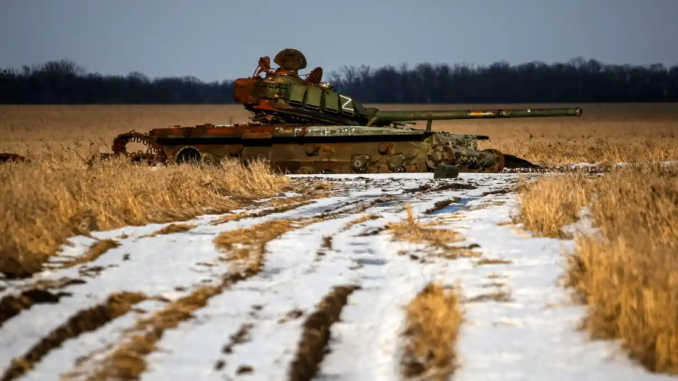
he festival of St Tryphon – the patron saint of winemakers – attracted no tourists this year. This saint is very much loved in Bessarabia, the largely ethnic-Bulgarian area of Ukraine’s Odesa region, where the February feast is always a much-awaited event. This year, villagers pruned their vines and celebrated quietly by themselves.
Given the tragedy of the war in Ukraine, this tradition could have been abandoned altogether, for a number of local men have died at the front, and in the village cemeteries, their graves are still fresh. But to give up the tradition would be a form of capitulation and no one is prepared to do or even think about that.
The feast of St Tryphon is also the beginning of spring, when villagers clear their gardens and farmyards of winter debris, but it would take more than a few horsedrawn carts to deal with the scrap metal cluttering Ukraine’s farmland. We are talking hundreds of thousands, if not millions, of tonnes of military hardware scattered throughout areas that have seen hostilities.
As of 24 February, the Ukrainian army has destroyed 3,363 Russian tanks and more than 6,600 heavy armoured infantry vehicles. It is clear that Ukraine has also lost a lot of the same type of equipment. Each tank weighs at least 45 tonnes.
The large-scale military scrap metal remains lying on the ground, but small-scale military scrap – shell cartridges – is now being recycled in projects that are more artistic than industrial or military. Dozens of artists – professional and amateur – create images with these cartridges and the resulting works of art are sold by online auction. Proceeds are given to the army or used for humanitarian purposes.
Most of the cartridge-case art is sold in Ukraine, but the best works are sent for export to charity auctions in Europe. Such a project was set up by Victoria Matvienkiv, an art and design student in Ivano-Frankivsk, whose father is fighting in Zaporizhzhia region. Victoria asked him to bring cartridge cases so that she and her friends could paint them and raise money for the army. Her university has agreed to host the auction of the art on its website. Prices start at €8, but many fetch 10 times more.
Kharkiv artists, meanwhile, are exhibiting painted cartridge cases and helmets in Ternopil, in western Ukraine, a project to raise money for an apartment for the family of Nazar Myalikguliev, a soldier killed at the front whose widow and three children could no longer afford the rent on their apartment.
And this artistic recycling is not limited to metal goods such as cartridge cases and helmets. The Odesa region winemaker Oleksandr Shushpanov, who courageously opened a wine-tasting cellar in Odesa in October 2022, is using wooden shell crates to package gift sets of his products. Shushpanov also orders grenade-launcher tubes from the front. Once cleaned up, a tube can hold a bottle of wine and two glasses. The money goes to his wife, Olena, who runs a volunteer project producing light stretchers for carrying the wounded from the battlefield.
In Kyiv, there is another project – turning Russian-language books into pulp to raise money for humanitarian projects. The campaign is spearheaded not by the state, but by Ukrainian-language writers and cultural figures who believe that the presence of too many Russian-language books in libraries – both public and private – is a major cause of the Russian aggression.
Even museums are being recycled. In 1990, the Pushkin museum – named after the Russian poet – was opened in Kyiv. On 3 March 2022, the museum was renamed as the Museum of Early 19th Century Life in Kyiv. Another museum that some would like to see “recycled” is the one dedicated to the Russian author Mikhail Bulgakov, situated in Kyiv in the building where he lived during the dark days of the civil war, after the Bolshevik revolution.
Does Europe want Ukrainians as living partners or dead heroes?
It has been suggested that these premises should be given over to a museum in honour of the Ukrainian choirmaster and composer Alexander Koshetz, who was little known in his homeland until recently. In 1919, on behalf of the government of the Ukrainian People’s Republic, which had just declared independence from the Russian empire, Koshetz left Ukraine together with the chamber choir he created on a tour of Europe to acquaint the public with Ukrainian song culture. His story is worthy of a three-hour Hollywood biopic.
It is not yet clear how the story of the Bulgakov museum will end, but there is change in Mariinsky Park, in the centre of Kyiv, where the story of a monument to the Soviet general Nikolai Vatutin recently ended with its demolition. Vatutin was a figure of Soviet and Kremlin power, and the removal of his monument and grave has long been demanded by Ukrainian activists. Their wish was granted.
Now a village near Kharkiv that bears the name Vatutino, in honour of the Soviet general, has appealed to the Ukrainian parliament for its name to be changed. They want to call it Zaluzhnoye, which means “beyond the meadow”. The surname Zaluzhny means the same thing. It also happens to be the name of Valery Zaluzhny, the commander-in-chief of the Ukrainian army.
Andrey Kurkov is a Ukrainian novelist and the author of Death and the Penguin
END

Be the first to comment